Management Accounting Report: Absorption and Marginal Costing Methods
VerifiedAdded on 2020/01/28
|10
|2370
|49
Report
AI Summary
This report delves into the core concepts of management accounting, focusing on the application and comparison of absorption and marginal costing methods. It begins by preparing profit and loss statements using both costing methods for two quarters, followed by the creation of a reconciliation statement for each quarter. The report then critically evaluates and assesses the absorption costing method against the marginal costing system, highlighting their respective advantages and limitations. Absorption costing, which considers both direct and indirect costs, is presented as a method that provides a comprehensive view of profitability and inventory valuation. The report emphasizes its benefits, such as considering fixed costs and providing a fair view of profit margins. Conversely, the report acknowledges the marginal costing system, focusing on variable costs, and discusses its drawbacks, including the potential for misleading results due to the exclusion of fixed costs. The report concludes by summarizing the key differences between the two methods and asserting the superiority of absorption costing for providing reliable information to management and stakeholders, thereby facilitating sound decision-making. The report is supported by a comprehensive list of references to academic journals and online resources.
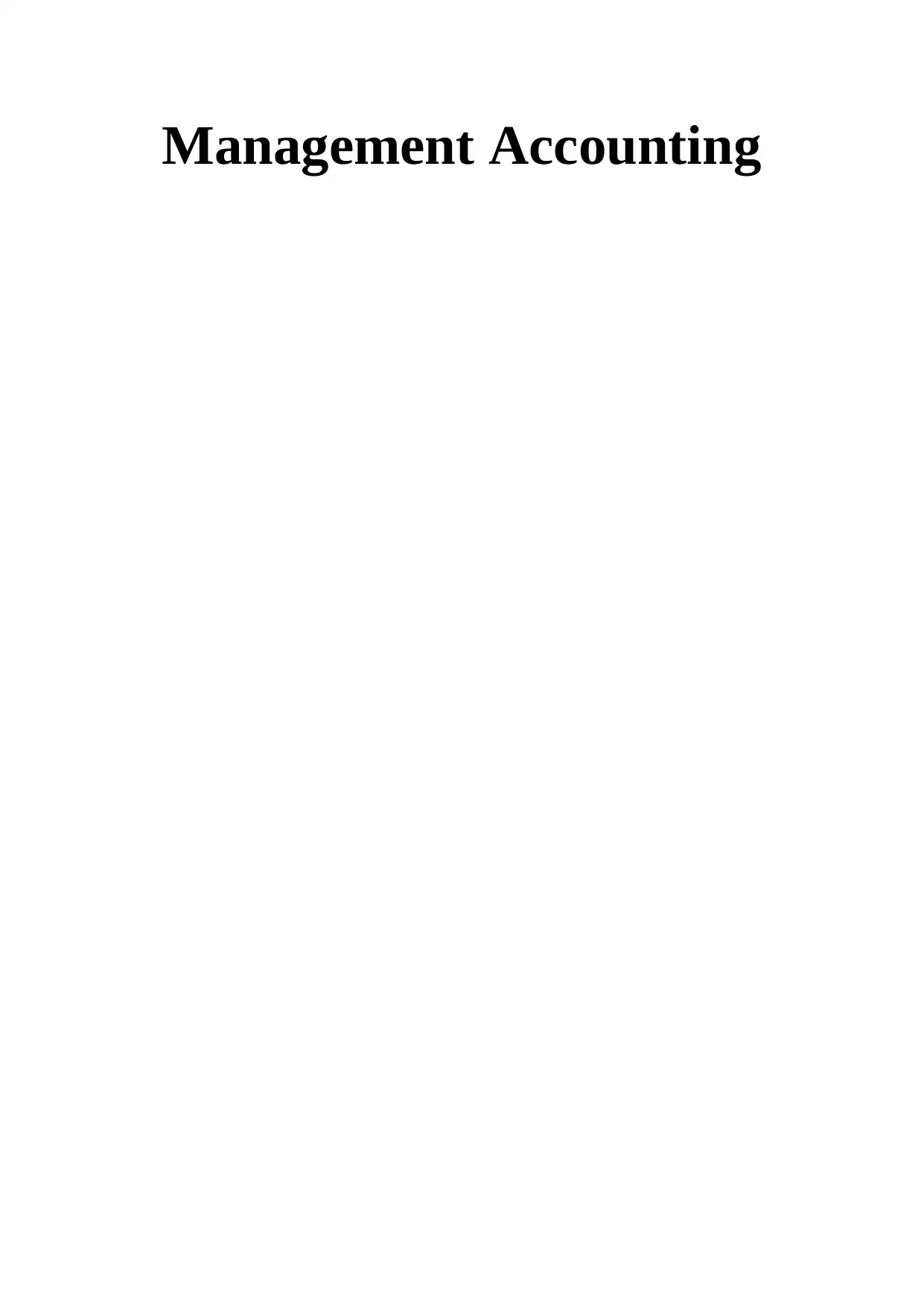
Management Accounting
Paraphrase This Document
Need a fresh take? Get an instant paraphrase of this document with our AI Paraphraser

Table of Contents
INTRODUCTION......................................................................................................................3
PART 1.......................................................................................................................................3
1. Preparing profit & loss a/c by using both marginal and absorption costing method.........3
2. Producing a reconciliation statement for each quarter.......................................................5
PART 2.......................................................................................................................................5
Critically evaluating and assessing absorption costing method in against to marginal
system.....................................................................................................................................5
CONCLUSION..........................................................................................................................8
REFERENCES...........................................................................................................................9
INTRODUCTION......................................................................................................................3
PART 1.......................................................................................................................................3
1. Preparing profit & loss a/c by using both marginal and absorption costing method.........3
2. Producing a reconciliation statement for each quarter.......................................................5
PART 2.......................................................................................................................................5
Critically evaluating and assessing absorption costing method in against to marginal
system.....................................................................................................................................5
CONCLUSION..........................................................................................................................8
REFERENCES...........................................................................................................................9

INTRODUCTION
Management accounting is highly concerned with the preparation of daily financial
reports in accordance with the cost principles and techniques. This field of finance is highly
significant which in turn helps company in making suitable business decision. Further,
management accounting system also provides assistance to the firm in setting highly suitable
price for the products and services which are offered by it. The present report is based on the
case scenario which will provide deeper insight deeper insight about different types of
costing methods such as absorption and marginal.
PART 1
1. Preparing profit & loss a/c by using both marginal and absorption costing method
Absorption costing method: P& a/c
Particulars Quarter 1 Quarter 2
Sales revenue
1740000
0
1957500
0
Less: Absorption cost of sales
Opening stock - 2328000
Add: Production cost 11640000
1396800
0
Total production cost
1164000
0
1629600
0
Less: Closing stock 2328000 5820000
Absorption cost of production 9312000
1047600
0 9099000
Gross profit 8088000
1026300
0
variable selling overhead 720000 810000
Fixed sales and distribution overhead 450000 450000
Less: Total selling and distribution
overhead 1170000 1260000
Normal Profit 6918000 7839000
Less: Under absorption
Net profit 6828000 7779000
P&L statement according to variable costing method:
Management accounting is highly concerned with the preparation of daily financial
reports in accordance with the cost principles and techniques. This field of finance is highly
significant which in turn helps company in making suitable business decision. Further,
management accounting system also provides assistance to the firm in setting highly suitable
price for the products and services which are offered by it. The present report is based on the
case scenario which will provide deeper insight deeper insight about different types of
costing methods such as absorption and marginal.
PART 1
1. Preparing profit & loss a/c by using both marginal and absorption costing method
Absorption costing method: P& a/c
Particulars Quarter 1 Quarter 2
Sales revenue
1740000
0
1957500
0
Less: Absorption cost of sales
Opening stock - 2328000
Add: Production cost 11640000
1396800
0
Total production cost
1164000
0
1629600
0
Less: Closing stock 2328000 5820000
Absorption cost of production 9312000
1047600
0 9099000
Gross profit 8088000
1026300
0
variable selling overhead 720000 810000
Fixed sales and distribution overhead 450000 450000
Less: Total selling and distribution
overhead 1170000 1260000
Normal Profit 6918000 7839000
Less: Under absorption
Net profit 6828000 7779000
P&L statement according to variable costing method:
⊘ This is a preview!⊘
Do you want full access?
Subscribe today to unlock all pages.

Trusted by 1+ million students worldwide

Quarter 1
Particulars
Amount
(in £)
Sales revenue
1740000
0
Less variable
expenses
COGS
1140000
0
goods available for
sale
1140000
0
Less: ending
inventory 2280000
Variable cost of
goods sold 9120000
Variable selling
expenses 720000 9840000
Contribution 7560000
Less fixed expenses
Production 240000
Sales and
administration 450000 690000
Net income 6870000
Quarter 2
Particula
rs
Amou
nt (in
£)
Sales
revenue
(1350000
* 14.5)
19575
000
Less
variable
expenses
Opening
inventory
(300000
* 7.6)
22800
00
COGS
(185000
0 * 7.6)
13680
000
Goods
available
for sale
(Beginnin
g stock +
Cogs )
15960
000
Less:
ending
inventory
(750000
* 7.6)
57000
00
Variable
cost of
(1596000
0 –
10260
000
Particulars
Amount
(in £)
Sales revenue
1740000
0
Less variable
expenses
COGS
1140000
0
goods available for
sale
1140000
0
Less: ending
inventory 2280000
Variable cost of
goods sold 9120000
Variable selling
expenses 720000 9840000
Contribution 7560000
Less fixed expenses
Production 240000
Sales and
administration 450000 690000
Net income 6870000
Quarter 2
Particula
rs
Amou
nt (in
£)
Sales
revenue
(1350000
* 14.5)
19575
000
Less
variable
expenses
Opening
inventory
(300000
* 7.6)
22800
00
COGS
(185000
0 * 7.6)
13680
000
Goods
available
for sale
(Beginnin
g stock +
Cogs )
15960
000
Less:
ending
inventory
(750000
* 7.6)
57000
00
Variable
cost of
(1596000
0 –
10260
000
Paraphrase This Document
Need a fresh take? Get an instant paraphrase of this document with our AI Paraphraser
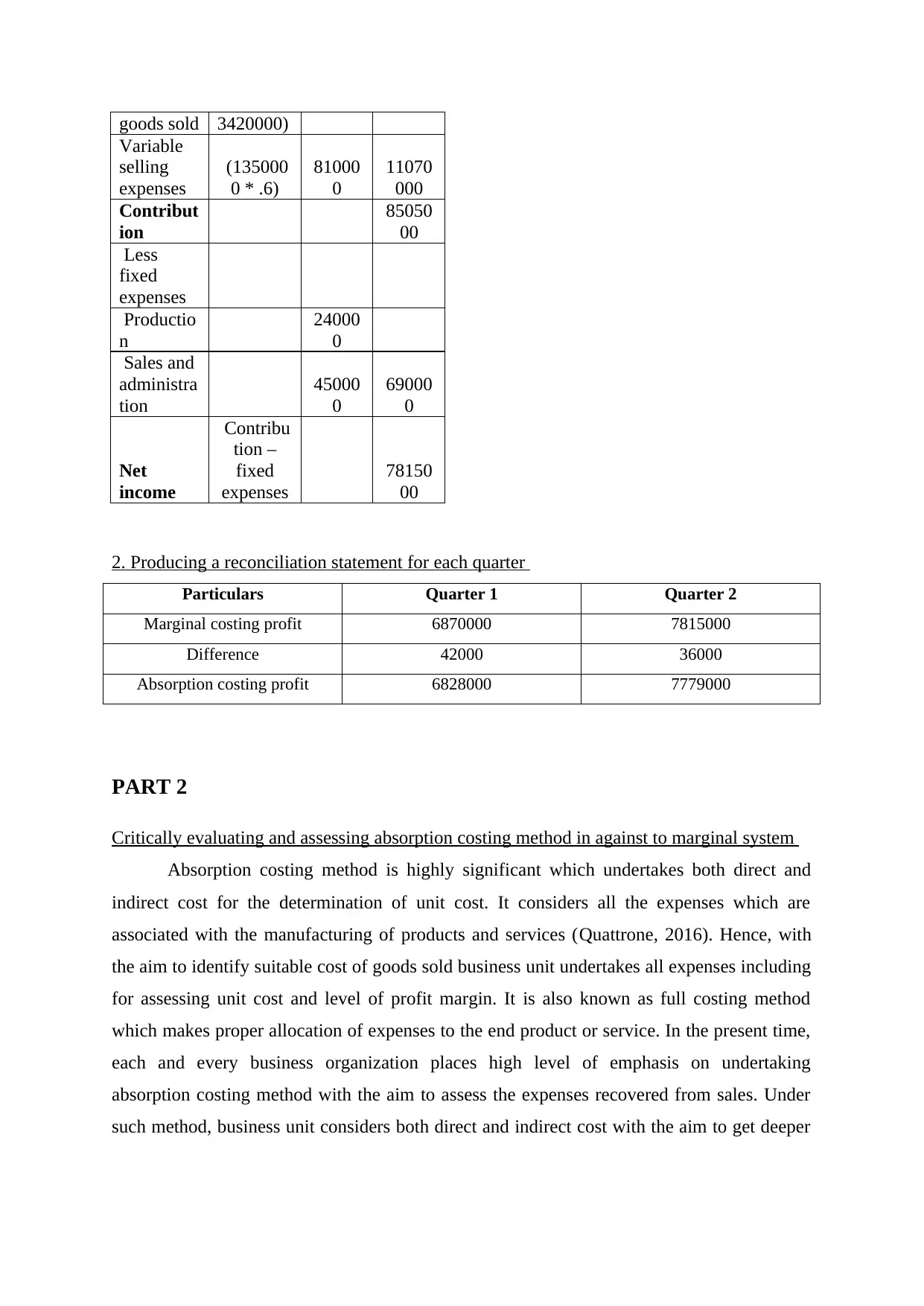
goods sold 3420000)
Variable
selling
expenses
(135000
0 * .6)
81000
0
11070
000
Contribut
ion
85050
00
Less
fixed
expenses
Productio
n
24000
0
Sales and
administra
tion
45000
0
69000
0
Net
income
Contribu
tion –
fixed
expenses
78150
00
2. Producing a reconciliation statement for each quarter
Particulars Quarter 1 Quarter 2
Marginal costing profit 6870000 7815000
Difference 42000 36000
Absorption costing profit 6828000 7779000
PART 2
Critically evaluating and assessing absorption costing method in against to marginal system
Absorption costing method is highly significant which undertakes both direct and
indirect cost for the determination of unit cost. It considers all the expenses which are
associated with the manufacturing of products and services (Quattrone, 2016). Hence, with
the aim to identify suitable cost of goods sold business unit undertakes all expenses including
for assessing unit cost and level of profit margin. It is also known as full costing method
which makes proper allocation of expenses to the end product or service. In the present time,
each and every business organization places high level of emphasis on undertaking
absorption costing method with the aim to assess the expenses recovered from sales. Under
such method, business unit considers both direct and indirect cost with the aim to get deeper
Variable
selling
expenses
(135000
0 * .6)
81000
0
11070
000
Contribut
ion
85050
00
Less
fixed
expenses
Productio
n
24000
0
Sales and
administra
tion
45000
0
69000
0
Net
income
Contribu
tion –
fixed
expenses
78150
00
2. Producing a reconciliation statement for each quarter
Particulars Quarter 1 Quarter 2
Marginal costing profit 6870000 7815000
Difference 42000 36000
Absorption costing profit 6828000 7779000
PART 2
Critically evaluating and assessing absorption costing method in against to marginal system
Absorption costing method is highly significant which undertakes both direct and
indirect cost for the determination of unit cost. It considers all the expenses which are
associated with the manufacturing of products and services (Quattrone, 2016). Hence, with
the aim to identify suitable cost of goods sold business unit undertakes all expenses including
for assessing unit cost and level of profit margin. It is also known as full costing method
which makes proper allocation of expenses to the end product or service. In the present time,
each and every business organization places high level of emphasis on undertaking
absorption costing method with the aim to assess the expenses recovered from sales. Under
such method, business unit considers both direct and indirect cost with the aim to get deeper

insight about profit or loss aspect (Wagenhofer, 2016). All these aspects show that absorption
costing method is highly effective as compared to other alternative systems.
Advantages of absorption costing method: There are several benefits which such costing
method carries with itself:
Fixed cost consideration: This method recognizes the importance of fixed cost while
making determination of gross and net profit. It assumes that fixed cost is also highly
associated with the production of goods and services (Kaplan and Atkinson, 2015).
Hence, business unit considers fixed cost for assessing the level of profit margin and
thereby presents fair view of monetary aspects to a great extent.
Avoidance of separation: This method completely ignores the cost separation in
terms of fixed and variable. Moreover, both costs are the main parts of production
activities which in turn help in turn helps in assessing the expenses incurred by firm
during the period (Fullerton, Kennedy and Widener, 2014). In this way, by deducting
both fixed and variable expenses from sales revenue company can determine the level
of profit.
Appropriate view of profit margin: Firm can also identify the suitable amount of
profit by employing the technique of absorption costing (Chenhall and Moers, 2015).
In this way, such method offers high level of benefit to the firm which is planning to
get desired level of profit margin from future sales.
In addition to this, such method provides high level of assistance to manager in
making proper valuation of stock (Fullerton, Kennedy and Widener, 2013). Thus, by
considering this manager of the firm can prepare highly suitable and effectual
business report.
Absorption costing is one of the most effectual reforms over the marginal system which
in turn helps in making valuation of stock and assessing profit margin in an effectual way.
Marginal costing system provides deeper insight about the extent to which changes
will take place in the cost and profit margin on the production of one additional unit. In other
words, marginal costing method entails the changes take place in cost sheet according to the
level of output. This method of costing is highly effectual which can be used by manager
with high level of ease (Suomala, Lyly-Yrjänäinen and Lukka, 2014). Moreover, such
method completely eliminates difficulties in relation to the allocation, apportionment and
absorption of overhead aspect. Thus, such method is highly free from the complication of
costing method is highly effective as compared to other alternative systems.
Advantages of absorption costing method: There are several benefits which such costing
method carries with itself:
Fixed cost consideration: This method recognizes the importance of fixed cost while
making determination of gross and net profit. It assumes that fixed cost is also highly
associated with the production of goods and services (Kaplan and Atkinson, 2015).
Hence, business unit considers fixed cost for assessing the level of profit margin and
thereby presents fair view of monetary aspects to a great extent.
Avoidance of separation: This method completely ignores the cost separation in
terms of fixed and variable. Moreover, both costs are the main parts of production
activities which in turn help in turn helps in assessing the expenses incurred by firm
during the period (Fullerton, Kennedy and Widener, 2014). In this way, by deducting
both fixed and variable expenses from sales revenue company can determine the level
of profit.
Appropriate view of profit margin: Firm can also identify the suitable amount of
profit by employing the technique of absorption costing (Chenhall and Moers, 2015).
In this way, such method offers high level of benefit to the firm which is planning to
get desired level of profit margin from future sales.
In addition to this, such method provides high level of assistance to manager in
making proper valuation of stock (Fullerton, Kennedy and Widener, 2013). Thus, by
considering this manager of the firm can prepare highly suitable and effectual
business report.
Absorption costing is one of the most effectual reforms over the marginal system which
in turn helps in making valuation of stock and assessing profit margin in an effectual way.
Marginal costing system provides deeper insight about the extent to which changes
will take place in the cost and profit margin on the production of one additional unit. In other
words, marginal costing method entails the changes take place in cost sheet according to the
level of output. This method of costing is highly effectual which can be used by manager
with high level of ease (Suomala, Lyly-Yrjänäinen and Lukka, 2014). Moreover, such
method completely eliminates difficulties in relation to the allocation, apportionment and
absorption of overhead aspect. Thus, such method is highly free from the complication of
⊘ This is a preview!⊘
Do you want full access?
Subscribe today to unlock all pages.

Trusted by 1+ million students worldwide
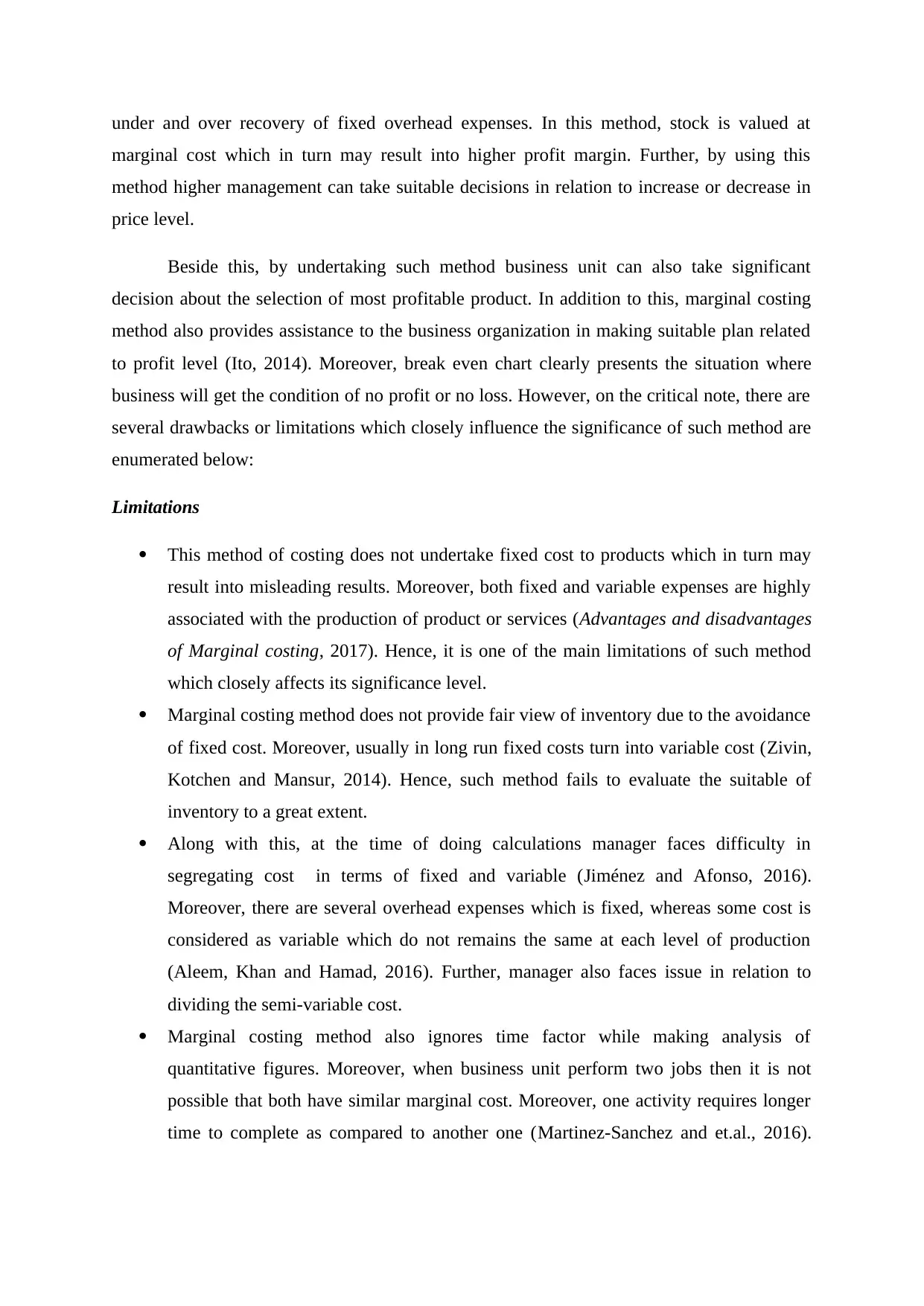
under and over recovery of fixed overhead expenses. In this method, stock is valued at
marginal cost which in turn may result into higher profit margin. Further, by using this
method higher management can take suitable decisions in relation to increase or decrease in
price level.
Beside this, by undertaking such method business unit can also take significant
decision about the selection of most profitable product. In addition to this, marginal costing
method also provides assistance to the business organization in making suitable plan related
to profit level (Ito, 2014). Moreover, break even chart clearly presents the situation where
business will get the condition of no profit or no loss. However, on the critical note, there are
several drawbacks or limitations which closely influence the significance of such method are
enumerated below:
Limitations
This method of costing does not undertake fixed cost to products which in turn may
result into misleading results. Moreover, both fixed and variable expenses are highly
associated with the production of product or services (Advantages and disadvantages
of Marginal costing, 2017). Hence, it is one of the main limitations of such method
which closely affects its significance level.
Marginal costing method does not provide fair view of inventory due to the avoidance
of fixed cost. Moreover, usually in long run fixed costs turn into variable cost (Zivin,
Kotchen and Mansur, 2014). Hence, such method fails to evaluate the suitable of
inventory to a great extent.
Along with this, at the time of doing calculations manager faces difficulty in
segregating cost in terms of fixed and variable (Jiménez and Afonso, 2016).
Moreover, there are several overhead expenses which is fixed, whereas some cost is
considered as variable which do not remains the same at each level of production
(Aleem, Khan and Hamad, 2016). Further, manager also faces issue in relation to
dividing the semi-variable cost.
Marginal costing method also ignores time factor while making analysis of
quantitative figures. Moreover, when business unit perform two jobs then it is not
possible that both have similar marginal cost. Moreover, one activity requires longer
time to complete as compared to another one (Martinez-Sanchez and et.al., 2016).
marginal cost which in turn may result into higher profit margin. Further, by using this
method higher management can take suitable decisions in relation to increase or decrease in
price level.
Beside this, by undertaking such method business unit can also take significant
decision about the selection of most profitable product. In addition to this, marginal costing
method also provides assistance to the business organization in making suitable plan related
to profit level (Ito, 2014). Moreover, break even chart clearly presents the situation where
business will get the condition of no profit or no loss. However, on the critical note, there are
several drawbacks or limitations which closely influence the significance of such method are
enumerated below:
Limitations
This method of costing does not undertake fixed cost to products which in turn may
result into misleading results. Moreover, both fixed and variable expenses are highly
associated with the production of product or services (Advantages and disadvantages
of Marginal costing, 2017). Hence, it is one of the main limitations of such method
which closely affects its significance level.
Marginal costing method does not provide fair view of inventory due to the avoidance
of fixed cost. Moreover, usually in long run fixed costs turn into variable cost (Zivin,
Kotchen and Mansur, 2014). Hence, such method fails to evaluate the suitable of
inventory to a great extent.
Along with this, at the time of doing calculations manager faces difficulty in
segregating cost in terms of fixed and variable (Jiménez and Afonso, 2016).
Moreover, there are several overhead expenses which is fixed, whereas some cost is
considered as variable which do not remains the same at each level of production
(Aleem, Khan and Hamad, 2016). Further, manager also faces issue in relation to
dividing the semi-variable cost.
Marginal costing method also ignores time factor while making analysis of
quantitative figures. Moreover, when business unit perform two jobs then it is not
possible that both have similar marginal cost. Moreover, one activity requires longer
time to complete as compared to another one (Martinez-Sanchez and et.al., 2016).
Paraphrase This Document
Need a fresh take? Get an instant paraphrase of this document with our AI Paraphraser
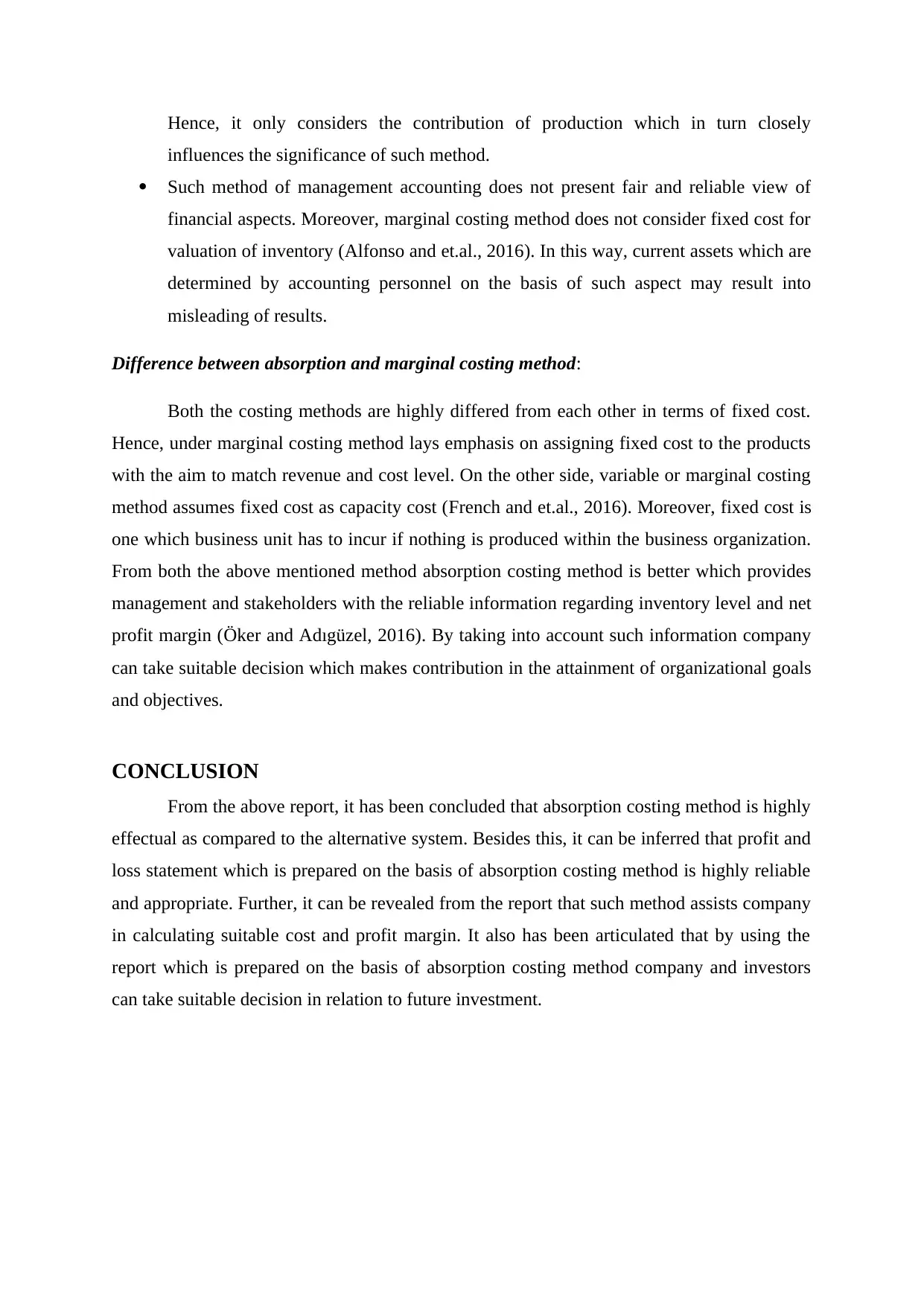
Hence, it only considers the contribution of production which in turn closely
influences the significance of such method.
Such method of management accounting does not present fair and reliable view of
financial aspects. Moreover, marginal costing method does not consider fixed cost for
valuation of inventory (Alfonso and et.al., 2016). In this way, current assets which are
determined by accounting personnel on the basis of such aspect may result into
misleading of results.
Difference between absorption and marginal costing method:
Both the costing methods are highly differed from each other in terms of fixed cost.
Hence, under marginal costing method lays emphasis on assigning fixed cost to the products
with the aim to match revenue and cost level. On the other side, variable or marginal costing
method assumes fixed cost as capacity cost (French and et.al., 2016). Moreover, fixed cost is
one which business unit has to incur if nothing is produced within the business organization.
From both the above mentioned method absorption costing method is better which provides
management and stakeholders with the reliable information regarding inventory level and net
profit margin (Öker and Adıgüzel, 2016). By taking into account such information company
can take suitable decision which makes contribution in the attainment of organizational goals
and objectives.
CONCLUSION
From the above report, it has been concluded that absorption costing method is highly
effectual as compared to the alternative system. Besides this, it can be inferred that profit and
loss statement which is prepared on the basis of absorption costing method is highly reliable
and appropriate. Further, it can be revealed from the report that such method assists company
in calculating suitable cost and profit margin. It also has been articulated that by using the
report which is prepared on the basis of absorption costing method company and investors
can take suitable decision in relation to future investment.
influences the significance of such method.
Such method of management accounting does not present fair and reliable view of
financial aspects. Moreover, marginal costing method does not consider fixed cost for
valuation of inventory (Alfonso and et.al., 2016). In this way, current assets which are
determined by accounting personnel on the basis of such aspect may result into
misleading of results.
Difference between absorption and marginal costing method:
Both the costing methods are highly differed from each other in terms of fixed cost.
Hence, under marginal costing method lays emphasis on assigning fixed cost to the products
with the aim to match revenue and cost level. On the other side, variable or marginal costing
method assumes fixed cost as capacity cost (French and et.al., 2016). Moreover, fixed cost is
one which business unit has to incur if nothing is produced within the business organization.
From both the above mentioned method absorption costing method is better which provides
management and stakeholders with the reliable information regarding inventory level and net
profit margin (Öker and Adıgüzel, 2016). By taking into account such information company
can take suitable decision which makes contribution in the attainment of organizational goals
and objectives.
CONCLUSION
From the above report, it has been concluded that absorption costing method is highly
effectual as compared to the alternative system. Besides this, it can be inferred that profit and
loss statement which is prepared on the basis of absorption costing method is highly reliable
and appropriate. Further, it can be revealed from the report that such method assists company
in calculating suitable cost and profit margin. It also has been articulated that by using the
report which is prepared on the basis of absorption costing method company and investors
can take suitable decision in relation to future investment.

REFERENCES
Books and Journals
Aleem, M., Khan, A. H. and Hamad, W., 2016. A comparative study of the different costing
techniques and their application in the pharmaceutical companies. The Audit Financiar
journal. 12(143).
Alfonso, Y. N. and et.al., 2016. Trends in the Marginal Cost of Male Circumcision in Rural
Rakai Uganda. JAIDS Journal of Acquired Immune Deficiency Syndromes. 73(5). pp.564-
571.
Chenhall, R. H. and Moers, F., 2015. The role of innovation in the evolution of management
accounting and its integration into management control. Accounting, Organizations and
Society. 47. pp.1-13.
French, K. E. and et.al., 2016. Value based care and bundled payments: Anesthesia care costs
for outpatient oncology surgery using time-driven activity-based costing. In Healthcare
(Vol. 4, No. 3, pp. 173-180). Elsevier.
Fullerton, R. R., Kennedy, F. A. and Widener, S. K., 2013. Management accounting and
control practices in a lean manufacturing environment. Accounting, Organizations and
Society. 38(1). pp.50-71.
Fullerton, R. R., Kennedy, F. A. and Widener, S. K., 2014. Lean manufacturing and firm
performance: The incremental contribution of lean management accounting practices.
Journal of Operations Management. 32(7). pp.414-428.
Ito, K., 2014. Do consumers respond to marginal or average price? Evidence from nonlinear
electricity pricing. The American Economic Review. 104(2). pp.537-563.
Jiménez, V. and Afonso, P., 2016. Risk assessment in costing systems using costing at risk
(CaR): An application to the Coffee production cost. In Industrial Engineering and
Engineering Management (IEEM), 2016 IEEE International Conference on (pp. 1315-
1319). IEEE.
Kaplan, R. S. and Atkinson, A. A., 2015. Advanced management accounting. PHI Learning.
Books and Journals
Aleem, M., Khan, A. H. and Hamad, W., 2016. A comparative study of the different costing
techniques and their application in the pharmaceutical companies. The Audit Financiar
journal. 12(143).
Alfonso, Y. N. and et.al., 2016. Trends in the Marginal Cost of Male Circumcision in Rural
Rakai Uganda. JAIDS Journal of Acquired Immune Deficiency Syndromes. 73(5). pp.564-
571.
Chenhall, R. H. and Moers, F., 2015. The role of innovation in the evolution of management
accounting and its integration into management control. Accounting, Organizations and
Society. 47. pp.1-13.
French, K. E. and et.al., 2016. Value based care and bundled payments: Anesthesia care costs
for outpatient oncology surgery using time-driven activity-based costing. In Healthcare
(Vol. 4, No. 3, pp. 173-180). Elsevier.
Fullerton, R. R., Kennedy, F. A. and Widener, S. K., 2013. Management accounting and
control practices in a lean manufacturing environment. Accounting, Organizations and
Society. 38(1). pp.50-71.
Fullerton, R. R., Kennedy, F. A. and Widener, S. K., 2014. Lean manufacturing and firm
performance: The incremental contribution of lean management accounting practices.
Journal of Operations Management. 32(7). pp.414-428.
Ito, K., 2014. Do consumers respond to marginal or average price? Evidence from nonlinear
electricity pricing. The American Economic Review. 104(2). pp.537-563.
Jiménez, V. and Afonso, P., 2016. Risk assessment in costing systems using costing at risk
(CaR): An application to the Coffee production cost. In Industrial Engineering and
Engineering Management (IEEM), 2016 IEEE International Conference on (pp. 1315-
1319). IEEE.
Kaplan, R. S. and Atkinson, A. A., 2015. Advanced management accounting. PHI Learning.
⊘ This is a preview!⊘
Do you want full access?
Subscribe today to unlock all pages.

Trusted by 1+ million students worldwide
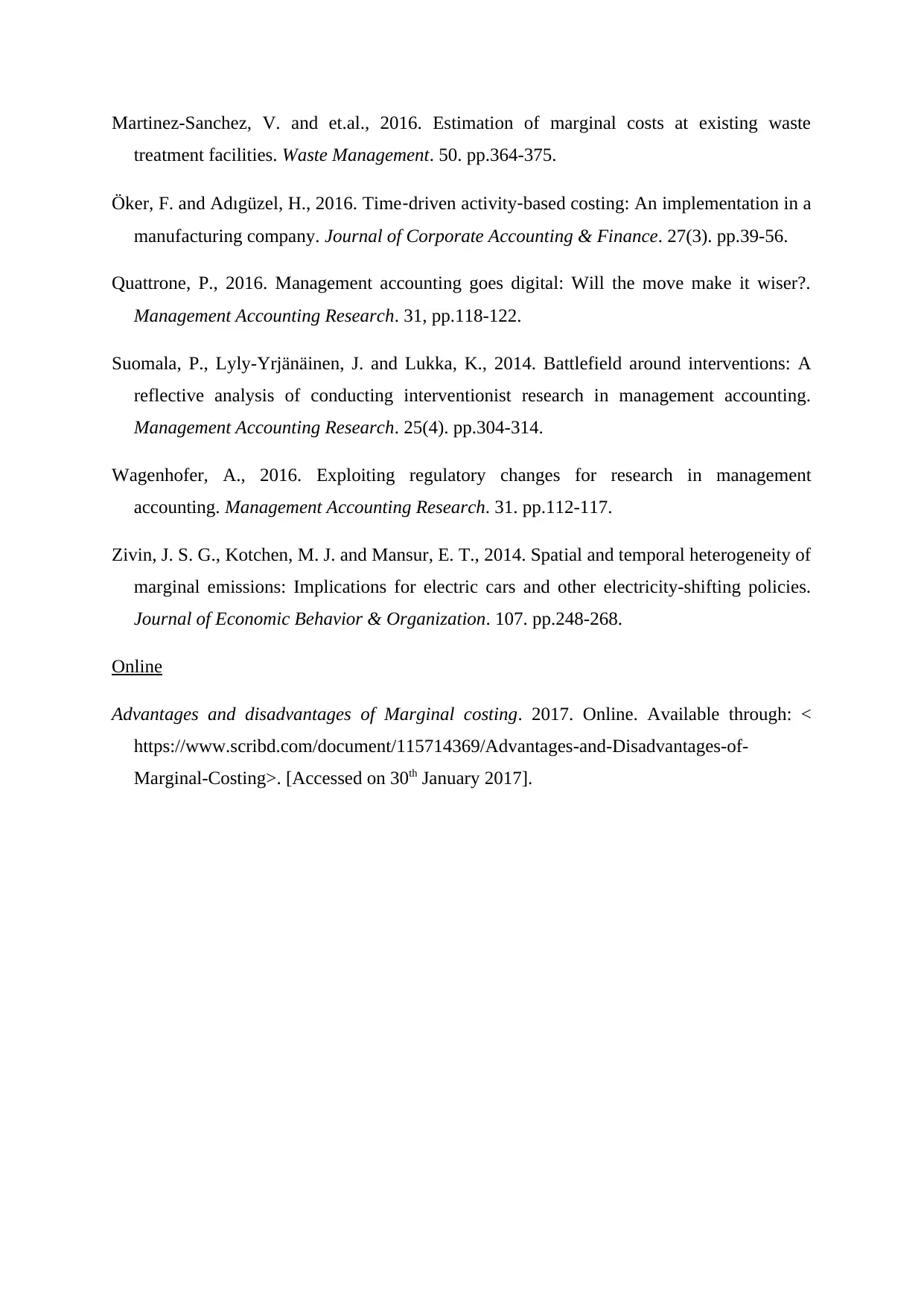
Martinez-Sanchez, V. and et.al., 2016. Estimation of marginal costs at existing waste
treatment facilities. Waste Management. 50. pp.364-375.
Öker, F. and Adıgüzel, H., 2016. Time‐driven activity‐based costing: An implementation in a
manufacturing company. Journal of Corporate Accounting & Finance. 27(3). pp.39-56.
Quattrone, P., 2016. Management accounting goes digital: Will the move make it wiser?.
Management Accounting Research. 31, pp.118-122.
Suomala, P., Lyly-Yrjänäinen, J. and Lukka, K., 2014. Battlefield around interventions: A
reflective analysis of conducting interventionist research in management accounting.
Management Accounting Research. 25(4). pp.304-314.
Wagenhofer, A., 2016. Exploiting regulatory changes for research in management
accounting. Management Accounting Research. 31. pp.112-117.
Zivin, J. S. G., Kotchen, M. J. and Mansur, E. T., 2014. Spatial and temporal heterogeneity of
marginal emissions: Implications for electric cars and other electricity-shifting policies.
Journal of Economic Behavior & Organization. 107. pp.248-268.
Online
Advantages and disadvantages of Marginal costing. 2017. Online. Available through: <
https://www.scribd.com/document/115714369/Advantages-and-Disadvantages-of-
Marginal-Costing>. [Accessed on 30th January 2017].
treatment facilities. Waste Management. 50. pp.364-375.
Öker, F. and Adıgüzel, H., 2016. Time‐driven activity‐based costing: An implementation in a
manufacturing company. Journal of Corporate Accounting & Finance. 27(3). pp.39-56.
Quattrone, P., 2016. Management accounting goes digital: Will the move make it wiser?.
Management Accounting Research. 31, pp.118-122.
Suomala, P., Lyly-Yrjänäinen, J. and Lukka, K., 2014. Battlefield around interventions: A
reflective analysis of conducting interventionist research in management accounting.
Management Accounting Research. 25(4). pp.304-314.
Wagenhofer, A., 2016. Exploiting regulatory changes for research in management
accounting. Management Accounting Research. 31. pp.112-117.
Zivin, J. S. G., Kotchen, M. J. and Mansur, E. T., 2014. Spatial and temporal heterogeneity of
marginal emissions: Implications for electric cars and other electricity-shifting policies.
Journal of Economic Behavior & Organization. 107. pp.248-268.
Online
Advantages and disadvantages of Marginal costing. 2017. Online. Available through: <
https://www.scribd.com/document/115714369/Advantages-and-Disadvantages-of-
Marginal-Costing>. [Accessed on 30th January 2017].
1 out of 10
Related Documents
Your All-in-One AI-Powered Toolkit for Academic Success.
+13062052269
info@desklib.com
Available 24*7 on WhatsApp / Email
![[object Object]](/_next/static/media/star-bottom.7253800d.svg)
Unlock your academic potential
Copyright © 2020–2025 A2Z Services. All Rights Reserved. Developed and managed by ZUCOL.




